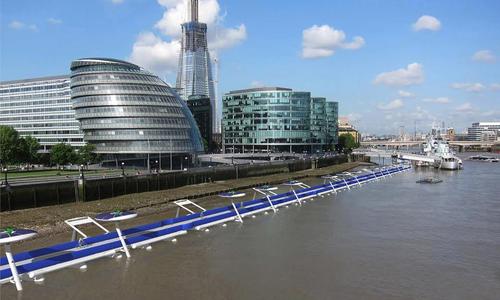October 15, 2014

Energy harvesting is a key part of a proposed new floating bikeway on the Thames River in London that would help provide a better way for people to commute in the traffic-congested city.
The Thames Deckway would run for eight miles close to the river's edge from the Battersea to Canary Wharf sections of the London waterfront, rising and falling slightly with the tidal cycle, according to a press release about the project from the designers behind it, the River Cycleway Consortium. It will generate its own energy from a series of devices that will line the pathway and use a combination of sources to make the path self-sustaining.
"The sun, the wind, and the river current are all readily available. Why not use them?" architect David Nixon, who together with Anna Hill co-founded the consortium, told Design News in an interview.

Nixon declined to elaborate on the design of the energy harvesters for "proprietary" reasons because the design is still in progress, but a published report on fastcoexist.com that Nixon confirmed to us was true revealed details.
As seen in a photo showing an artist's depiction of the bike path, the devices would look like mushroom-shaped lamps lining the bike path but would actually be multi-source energy harvesters. They would be covered with solar panels and also include a turbine that could harvest wind energy. The devices also would extend into the water to generate energy from the Thames' tides, according to the report.
The proposed bikeway also will be monitored by satellites, weather stations, and onboard sensors to relay information to Thames Deckway users about traffic densitv, traffic flow, river motion, river wave, or any potentially hazardous traffic or weather conditions, according to the consortium.
To keep traffic running smoothly, the proposed path will have four lanes -- two in each direction -- and use of the lanes would change throughout the day. During rush hour, only cyclists could use the lanes, but during other times, pedestrians will be permitted to use one lane in each direction. Weekends could see a pedestrian-only day with market stalls along the edge to promote community and commercial interests.
Whether the bikeway will ever get the green light to be developed remains to be seen. One major stumbling block may be the proposed cost -- GB pound 600 million, or nearly $1 billion. However, a single-price ticket for the path would be GB pound 1.50, or $2.40, so the Thames Deckway has the potential to generate revenue for the city, its developers said.
Related posts:
About the Author(s)
You May Also Like



